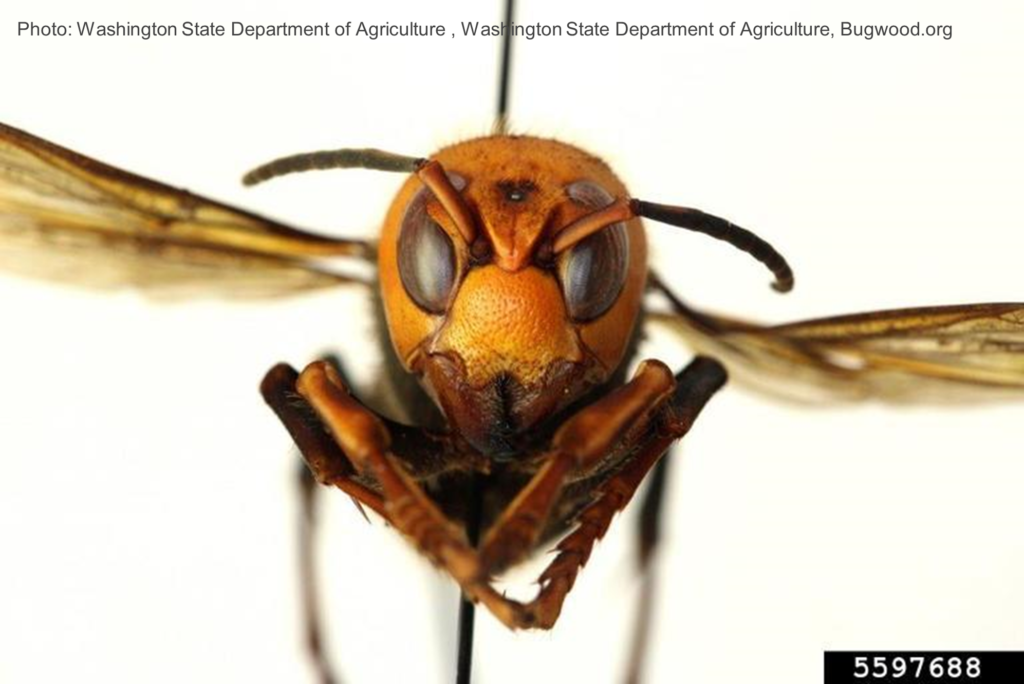
With warm weather approaching many people are eager to get outdoors.
We all know the characteristic buzzing sound of bees and hornets. However, having a close encounter with the northern giant hornet can be a shock.
Picture this: You hear it before you see it. The low drone quickly growing to a loud, grating buzzing. Then you see it, the orange-yellow face, dark coloured thorax, and abdomen banded with colours of orange-yellow and black or brown. It’s huge. An apex predator that targets honey bees.
This intimidating insect has caused quite a stir in the media, and we want you to know how to identify and report this invasive insect.
While their size is large enough to shock anyone, it is important to note that there are look-alike species that are commonly confused with northern giant hornets. It is common to see species like the European hornet, who closely resembles the northern giant hornet, emerge during the spring and summer.
Northern giant hornets, formally known as Asian giant hornets, are a predatory species of hornet that pose a serious threat to Ontario biodiversity and food industry.
Why You Should Care: The Impacts
Northern giant hornets prey on other insects. This carnivorous pest poses a serious threat to honey bee populations and can decimate entire bee colonies in just a few hours.
Bees play a vital role in the environment as pollinators. Reduced honey bee populations due to the predation of the northern giant hornet would result in a substantial impact on North American ecosystems and agriculture industries.
Furthermore, they don’t typically bother humans or animals. These hornets are highly territorial and will become aggressive when disturbed.
Although stings are rare, here’s what you should do if you are stung:
- Thoroughly wash the area with soap and water
- Apply an ice pack
- If necessary, take an antihistamine or apply insect sting cream to reduce itching
Seek medical attention if you have any signs of an allergic reaction or if you are stung multiple times. (“Northern Giant Hornets and Human health,” n.d.)

What to Look For: Identification
Northern giant hornets are the largest species of hornet in the world and are active from spring to mid-summer. The queens can grow to be more than 5 cm (2 inches) in length and have a wingspan that can exceed 7.6 cm (3 inches). Male and female workers are smaller, ranging from 3.5 to 3.9 cm (1.5 inches) in body length.
They have large, orange-yellow or brown heads and a black or dark brown thorax. Their abdomens are banded with orange-yellow and black or brown, and the tip where the stinger is located is yellow.
These hornets are ground nesters. They live in underground colonies which they create by digging, utilizing old tunnels, and occupying the spaces near tree roots.

Lookalikes
Northern giant hornets may be confused with other species of hornets found in Ontario. The most prominent difference between northern giant hornets and other species is their large size.
The European hornet is the most commonly confused species with the northern giant hornet. This species is smaller, typically 2.5 cm to 3.5 cm (1 inch to 1 ⅜ inches) and has a dark red or brown head and thorax. Their abdomens are yellow and striped with black/dark reddish brown. They have characteristic black keyhole shaped markings attached to their stripes. These hornets emerge during spring and are active throughout spring and summer. Although European hornets are not native to Canada, they are naturalized in some areas of Ontario, and do not pose any environmental threats.

The bald-faced hornet is another species common in Ontario that may be mistaken for the northern giant hornet. They are much smaller, approximately 1.2 cm to 2 cm (¾ inches) in length and are mainly black with white markings on their head, thorax, and abdomen.

The eastern cicada killer is a solitary wasp native to eastern North America and parts of southwestern Ontario. It ranges in size from about 1.5 cm to 5 cm (0.6 inches to 2 inches) long and has a dark coloured body with broken bands of yellow on its abdomen.

Yellowjackets is the general term for the various species of predatory social wasps that make up the genera Vespula and Dolichovespula. They range in length from about 1 cm to 2.5 cm (0.5 inches to 1 inch) and, depending on the species, may have bright yellow and black markings (e.g. western yellowjacket) or black and white markings (e.g. baldfaced hornet).

Where Have Northern Giant Hornets Been Found?
Northern giant hornets were first detected in the Nanaimo area of British Columbia in August 2019. They have also been found in Washington, United States.
Fortunately, there is currently no evidence of the northern giant hornet in Ontario. This means that we must continue to be vigilant and work to prevent their introduction and establishment.
So, how can you help?
Reporting
The spread of this invasive hornet poses a major threat to the wellbeing of our environment and society. You can help by reporting any sightings of this pest or its nest. In Ontario you can report to eddmaps.org or call the Invading Species Hotline at 1-800-563-7711. For all other provinces please visit the Report A Sighting page on our website to find out how you can report. Please provide a photo if it is possible to take it safely.
References
Northern Giant Hornets and Human health. (n.d.). Washington State Department of Agriculture. https://agr.wa.gov/departments/insects-pests-and-weeds/insects/hornets/human-health
